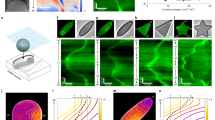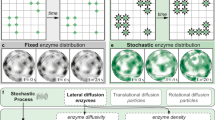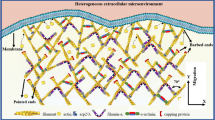Abstract
Cell motility is important for many physiological processes and the underlyingbiochemical reactions motility have been well-characterized. Mathematical models, usingthe biochemical reactions and focused on different types of spreading behavior have beenconstructed and analyzed. In this study, we build on these previous models to develop athree-dimensional stochastic model of isotropic spreading of mammalian fibroblasts. The model is composed of three actin remodeling reactions that occur stochastically in space and time and are regulated by membrane resistance forces. Numerical simulations indicate that the model qualitatively captures the experimentally observed isotropic cell spreading behavior. We analyzed the effects of varying branching reaction rates, membrane resistance forces and capping protein concentrations on the dynamics of isotropic spreading. The simulations allowed us to identify the range within which branching reaction rates and membrane force values cooperate to yield isotropic spreading behavior. The model predicts increasing capping protein concentration would lead to a linear decrease in average peripheral velocity. We tested this prediction experimentally using varying concentrations of a pharmacologic agent (Cytochalasin D)that caps growing actin filaments. We find that the experimental results agree with the numerical simulations. Thus, a spatio-temporally complex model made up of a simple set of stochastic reactions near the cell surface, when constrained by membrane forces, can yield deterministic behavior as characterized by isotropic cell spreading.
Similar content being viewed by others
Article PDF
Author information
Authors and Affiliations
Corresponding authors
Rights and permissions
About this article
Cite this article
Xiong, Y., Rangamani, P., Dubin-Thaler, B. et al. A Three dimesional stochastic spatio-temporal model of cell spreading. Nat Prec (2007). https://doi.org/10.1038/npre.2007.62.1
Received:
Accepted:
Published:
DOI: https://doi.org/10.1038/npre.2007.62.1



